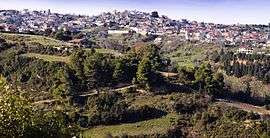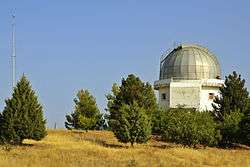Kryoneri, Corinthia
Kryoneri (Greek: Κρυονέρι, before 1955: Μάτζανη - Matzani[2]) is a village in Corinthia regional unit, Greece. It is 42 km southwest of Corinth, built at 740 m height, in the slopes of Velisa mountain (part of Cyllene mountain). Kryoneri is part of the municipality of Sikyona. The village was flown through by a stream, tributary of Elisson River.[3][4] Kryoneri has panoramic view towards northeast Corinthia until the coasts of Saronic and Corinthian gulf. Its population is 868 inhabitants according to 2011 census.
Kryoneri Κρυονέρι | |
|---|---|
 Panoramic view of Kryoneri | |
 Kryoneri | |
| Coordinates: 37°52′N 22°35′E | |
| Country | Greece |
| Administrative region | Peloponnese |
| Regional unit | Corinthia |
| Municipality | Sikyona |
| Elevation | 740 m (2,430 ft) |
| Population (2011)[1] | |
| • Rural | 868 |
| Time zone | UTC+2 (EET) |
| • Summer (DST) | UTC+3 (EEST) |
| Vehicle registration | ΚΡ |
History
The first name of the settlement was Mergeni, which possibly means grass land.[4] This name derived from the Franks who dominated the Peloponnese during the 13th and 14th centuries. The current name was given in 1954 which means a place with cold water. The village took part in the Greek War of Independence, where a chieftain from Kryoneri with the surname Stergiopoulos is mentioned.[3]
Historical population
| Census | Population |
|---|---|
| 2001 | 961 |
| 2011 | 868 |
Places of interest

The Kryoneri Astronomical Station observatory was built in 1974–75 at a height of 1000 meters. It has the second biggest telescope in Greece after the Chelmos Observatory. Its catoptric lens is 122 cm diameter.[5]
Located 4 km southwest of the village is the monastery of the Assumption of the Theotokos Lechova. It is built at 1050 m height. The catholicon of the monastery dates from Byzantine times, while other parts of the monastery belong to the 12th or 13th centuries.[6]
Near the village there is a cemetery of the Mycenaean era.[4] It includes ruins of 10 vaulted tombs. In the place Koutroumbi there are some ruins of a Mycenaean acropolis.
References
- "Απογραφή Πληθυσμού - Κατοικιών 2011. ΜΟΝΙΜΟΣ Πληθυσμός" (in Greek). Hellenic Statistical Authority.
- Name changes of settlements in Greece
- "Kryoneri". municipality of Sikyona. Retrieved 16 June 2014.
- "Kryoneri Corinthias". dim-kryon.kor.sch.gr. Retrieved 16 June 2014.
- "Αστεροσκοπείο Κρυονερίου". municipality of Sikyona. Retrieved 16 June 2014.
- "Ιερά Μονή Κοιμήσεως Θεοτόκου Λέχοβας". municipality of Sikyona. Retrieved 16 June 2014.